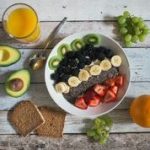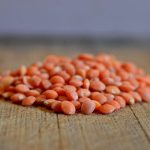Fuelling your little vegan
Tuesday, June 15, 2021
Louise Palmer Masterson from Stem & Glory shares some top tips for making vegan food more appealing to kids and to ensure that their diet is balanced.


Fuelling your little vegan | Louise Palmer Masterson | Stem & Glory
You’ve probably never had your kids likened to a petrol strimmer, but here goes: A strimmer is fuelled mainly by unleaded petrol, but you need to add the correct amount of semi-synthetic 2-stroke oil. Giving your strimmer just petrol, or just 2-stroke oil, or getting the mix wrong will leave your strimmer suffering with some nasty symptoms. Your kids, just like a strimmer, need the right fuel.
So, what do you do if your little strimmer announces that from now on its fuel needs to be vegan? The answer isn’t panic!
Some people question if a vegan diet is safe for children, but the world is full of healthy vegan children with parents who ensure plant-based meals balance protein and healthy fats, and pay particular attention to vitamin D, vitamin B12, calcium, zinc and iron.
The first thing you need to do if you are considering raising vegan children is to educate yourself. If you don’t already love to cook, it is time to embrace your inner Mary Berry (other celeb chefs/cooks are available) and begin a love affair with lentils, beans, nuts, seeds and a wild array of vegetables.
But before we get to that, a few thoughts for mothers-to-be who’ve been nudged towards a plant-based lifestyle by David Attenborough’s sage warnings about climate change or by horror stories about where their supermarkets source their eggs.
The best possible start in life for your baby is breastfeeding, and for you to eat a healthy and balanced diet whilst feeding. It’s wise for this reason that you continue to take a pregnancy safe vitamin supplement. That will pass on the best possible nutrition to your child. Don’t be in a hurry to stop breastfeeding. There are no vegan baby formula milk products currently in the UK market, although they will no doubt emerge in the not-too-distant future. Do not be tempted to give your infant plant-based milk substitutes, as they will not have the nutrition your child needs (same goes for feeding an infant plain cow’s milk).
Every child is different when it comes to weaning, my eldest breastfed until more than two years old, and the Vegan Society advice is to continue breastfeeding until your child is two years old if possible. My youngest however stopped the minute they discovered proper food at 10 months, so don’t beat yourself up if your child doesn’t seem to want to keep breastfeeding. If you do stop breastfeeding before two years, you will need to pay special attention to a good balance of nutrition, minerals and vitamins. If this is the case, and you are worried about this, consider fortified baby foods such as baby cereal.
Both my children were weaned first on blended banana and avocado, which is a legend in our house, and graduated to blended lentils and vegetables, thick soups and baby versions of what we were eating. It’s sensible to pay attention to a vegetable protein component at each meal, for example lentils, beans or quinoa along with vegetables and healthy fats. Babies can eat nuts and seeds, but only if ground or completely blended.
With regard to vitamin B12, which all vegans should be mindful of, there are a number of fortified foods to consider as your child starts to eat more and breastfeed less.
The best possible thing you can do with regard to young children and B12 is get them to fall in love with marmite (yeast extract is also good). A go-to snack of toast and marmite will contain plenty of B12.
But what about the fussy eater who falls on the yuck! side of the Marmite fence? Be sneaky. We use marmite in many savoury dishes, including soups, stews and the best vegan gravy ever.
We also use Engevita flakes as a cheese substitute, sprinkled on pasta and in many sauces. Engevita is super charged with B12.
I’d also recommend getting your children to become best friends with hummus. It’s super nutritious and super available; hummus (there are many flavour varieties available) served with pitta and carrot and cucumber sticks is a winner with most children. Served together in this way, hummus and pitta is what’s called a complete protein – between them, pitta and hummus contain the full spectrum of amino acids that you need.
There is a lot of talk about getting the full spectrum of these essential amino acids that is generally misunderstood. Animal-based proteins contain all nine essential amino acids, which makes them complete proteins, but it is not actually necessary to eat one food that contains everything. That’s where the idea that vegans lack protein comes in, which is false. Combining plant foods results in complete protein and gives exactly the same result nutritionally.
There are a few plant-based foods that are ‘complete’ proteins on their own—they contain the full spectrum amino acids—and these include tofu, tempeh, edamame beans, quinoa, buckwheat, amaranth and chia seeds. Some of these can be a bit of an acquired taste for little ones. Quinoa, for example, will likely need to be smuggled into a tasty-flavoured sauce. But my kids always did well with edamame beans, scrambled tofu and fresh fruit chia pudding.
However, rather than focus on just these foods, your protein repertoire can expand massively by combining vegan proteins from different sources (like the hummus and pitta example above) which alone are not complete, both together magically provide a complete protein.
It’s worth noting, by the way, that 100g of wholemeal bread contains 13g of protein, which is more than in 100g of egg, and all vegetables do have a protein component. A diet rich in vegetables can make a significant contribution to your daily nutritional needs, including protein.
Always keep a tin of baked beans and/or a jar of peanut butter on stand-by. A peanut butter sandwich or beans on toast gives you instant complete protein.
Both brown and white rice when combined with beans or lentils give a complete protein. And there are literally millions of recipes out there containing beans or lentils, rice (or other grains) and vegetables. Just about every continent on the planet has a version of this cuisine.
Your child’s fuel requirements require a bit more thought than your strimmer’s, but it’s all about paying attention to a protein and vegetable component with every meal, keeping an eye on where they are getting their B12 from, providing their other nutrients from as wide variety of vegetables of all colours and types as possible, and making their favourite dishes as balanced and tasty as possible.

ABOUT THE AUTHOR
Louise Palmer-Masterton is founder of multiple award-winning restaurants Stem & Glory; hip and trendy but accessible plant-based restaurants, serving delicious gourmet vegan food from locally sourced ingredients. Stem & Glory also offers click-and-collect and local delivery in London and Cambridge. In addition, Stem & Glory offers a range of ready meals, finish at home pizzas, and recipe kits available for delivery across the UK.
Web: www.stemandglory.uk
Twitter: @stemandglory
Facebook: https://www.facebook.com/stemandglory/
Instagram: @stemandglory
Linked in: https://www.linkedin.com/in/louisepalmermasterton)
https://www.linkedin.com/company/stem-glory/




What Do You Think?
Recommend this content to other Eating Ideas readers by giving it a thumbs up!
Or why not tell us what you think by leaving a comment?